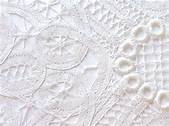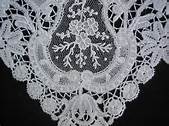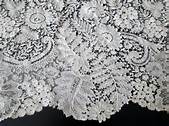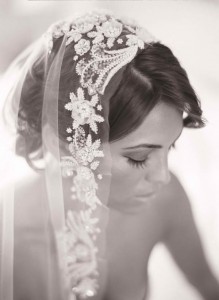
Our Blog at Iowa Bridal Preservation
I would really like to wear my grandmothers wedding veil on my wedding day...
Dec 15, 2013
...but it is old and fragile and not the same color as my dress is there any help? The bridal veil symbolizes the chastity and purity of the bride, and maybe that is why, at least in Western Culture it appears to be so important. By history, great attention and meaning has been attributed to the wearing of the veil during weddings in almost all cultures around the world. If your mother's or your grandmother's wedding gown is just not for you, you can still honor a family member by wearing her vintage bridal veil. Even if the lace-trimmed veil worn by your mother or the Brussels lace veil worn by your grandmother is yellowed and stained, a vintage bridal veil can look like new after bridal veil restoration. First, it's important to talk to an expert to find out what the fabrication of the veil is - different materials require different procedures for cleaning and restoration. Worried that the veil is too old?
Members of the Association of Wedding Gown Specialists have completed bridal veil restorations on veils made as long ago as 1835. Many vintage veils are made from variations of Brussels lace such as Point de Gaze, Duchesse, and Princesse as well as combinations of the designs that give these laces their names. All are cotton and can be restored. However, the silk in Blonde lace makes it fragile, and Blonde lace veils may need to be lined with tulle. Brussels lace is a type of pillow lace that originated in and around Brussels. The term "Brussels lace" has been broadly used for any lace from Brussels; however, the term strictly interpreted refers to bobbin lace, in which the pattern is made first, then the ground, or reseau, added, also using bobbin lace. Brussels lace is not to be confused with Brussels point, which is a type of needle lace, though is sometimes also called "Brussels lace." If you have an interest in lace, its history and uses, one can become deeply involved in a simple internet search. The history of lace worldwide is a fantastic venture, and if you are lucky enough to have in your possession vintage lace of any type, your new understanding of how it was made may add another wonderful dimension to your wearing it.



Occasionally the tulle or net center panel of bridal veils from the 1920s and 1930s is too damaged to use, but the lace border can be restored and appliqued onto a new center panel made from a sturdy nylon or polyester net. Silk illusion, popular in the 1950s and 1960s, is simply too fragile to restore, and it is probably best to copy the original bridal veil in a modern tulle or net. Luckily as early as the 1960s, designers began making bridal veils from synthetics such as nylon or polyester, and such veils, often trimmed with cotton lace, restore beautifully. Oddly, the cotton lace used to trim a vintage veil will often be more discolored than both silk and synthetic tulle and net, but when restored, the entire veil returns to a uniform color.
To keep your antique veil in the best possible condition and to ensure that it will be in good order to hand down through the generations there are some very important points to remember. In particular, a wedding veil should always be stored in as clean a condition as possible. Put in simple terms, it is invisible dirt and contaminants, (white wine, greasy fingers etc.) acting together with the ultra-violet part of sunlight and oxygen that causes oxidization of the cellulose fibres which promotes deterioration. This leads to the "antique" color of much old lace, but worse, can result in un-repairable damage to the veil.
If you like the antique color it is better to have a clean veil that is sympathetically and safely dyed to the color of your choice. Veils should never be stored in plastic bags as these will trap in moisture leading to damage. Cardboard will allow breathing and prevent moisture build up, but as importantly will not allow the fibers to dry out either which will cause brittleness in the threads. Storage in light will cause yellowing and deterioration with time so we suggest storing your veil in the dark. Wrapping the veil in acid free tissue will buffer the veil against harmful acids present in the air and other storage mediums. Never use colored tissue as this could bleed dye if it became damp. Annually remove your veil from its wrapping and inspect for any staining or other signs of damage. If any should be found have it treated professionally as soon as possible. If your veil gets stained in any way, especially champagne and white wine which will not show at the time, you must ensure that the veil is properly cleaned as soon as is possible. Any dirt stains or other contaminants will cause discoloration and damage over long time spans such as found between family weddings. Your veil should be attached and removed from any hair attachments such as combs or Alice bands as near to your wedding day and as soon afterwards as possible. Any tension on the threads of the net ground due to attaching stitches may cause distortion of the mesh over time.
Vintage Bridal Veil Restoration
When restored, vintage Brussels lace veils and vintage veils trimmed with Chantilly, Alencon, and other types of lace are lovely with today's bridal gowns. Most vintage lace is made from sturdy cotton that can be safely returned to the true color. Point de Gaze (also called Rosepoint) and Duchesse, for example, nearly always restore beautifully. Heirloom restoration and preservation of vintage bridal veils is a service at Iowa Bridal Presrvation. If you would like to honor a family member by including a treasured wedding accessory in your wedding, let us remove the ugly brown stains and yellowing from your vintage veil, ring pillow, or wedding pouch. Although not every vintage bridal veil, ring pillow, or wedding pouch can be restored, we can usually predict whether the project will be successful, and there is never a charge for evaluation. Bring your vintage wedding accessories to Iowa Bridal Preservation and allow us to discuss your interest in veil restoration and cleaning.
by Ed | Dec 15th, 2013 | Comments are closed.

